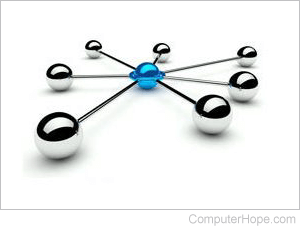Protocol

Sometimes called an access method, a protocol is a standard used to define a method of exchanging data over a computer network, such as local area network, Internet, Intranet, etc. Each protocol has its own method of how to handle data in the following situations.
- How data is formatted when sent.
- What to do with data once received.
- How data is compressed.
- How to check for errors in the data.
Likely the most important protocol is TCP/IP (transmission control protocol/Internet protocol) which is used to govern the communications of every computer connected to the Internet. HTTP (Hypertext Transfer Protocol), used to transmit data over the World Wide Web (Internet), is "carried" by TCP/IP. Below are various protocols currently listed in the Computer Hope dictionary.
A | B | C | D | E | F | G | H | I | J | K | L | M
N | O | P | Q | R | S | T | U | V | W | X | Y | Z
| A |
| ADSI (Active Directory Service Interface)
Aloha
AppleTalk
ARP (Address Resolution Protocol)
ASP (AppleTalk session protocol)
|
| B |
| BGMP (Border Gateway Multicast Protocol)
BGP (Border Gateway Protocol)
BOOTP (BOOTstrap Protocol)
|
| C |
| CHAP (Challenge-Handshake Authentication Protocol)
CIFS (common Internet file system)
CTCP (client-to-client protocol)
|
| D |
| DDP (Datagram Delivery Protocol)
DHCP (Dynamic Host Configuration Protocol)
|
| E |
| EAP (Extensible Authentication Protocol)
EDIINT (electronic data interchange-Internet integration)
EIGRP (Enhanced Interior Gateway Routing Protocol)
Ethernet
EtherTalk
|
| F |
| FDHP (Full Duplex Handshaking Protocol)
Frame relay
FSP (File Sharing Protocol)
FTP (file transfer protocol)
|
| G |
| None
|
| H |
| H.323
HDLC (high-level data link control)
HTTP (hypertext transfer protocol)
|
| I |
| ICA (independent computing architecture)
ICMP (Internet Control Message Protocol)
IGES (Initial Graphics Exchange Specification)
IGMP (Internet Group Management Protocol)
IGP (Interior Gateway Protocol)
IGRP (interior gateway routing protocol)
IMAP (Internet Message Access Protocol)
IP (Internet Protocol)
IPsec
IPv4
IPv6
IPX/SPX (Internet Packet Exchange/Sequential Packet Exchange)
|
| J |
| None
|
| K |
| Kerberos
Kermit
|
| L |
| L2TP (Layer 2 Tunneling Protocol)
LAPM (link access procedure for modems)
LDAP (lightweight directory access protocol)
LFAP (Light-weight Flow Admission Protocol)
LPX (lean packet exchange)
|
| M |
| Mailto
MNP (Microcom Network Protocol)
MPLS (Multiprotocol Label Switching)
|
| N |
| NBT (NetBIOS over TCP/IP)
NCP (network control protocol)
NetBEUI (NetBIOS Enhanced User Interface)
NNTP (network news transfer protocol)
NSP (Name Server Protocol)
NTP (Network Time Protocol)
|
| O |
| OSPF (Open Shortest Path First)
|
| P |
| PEP (Packet Ensemble Protocol)
PIM (Protocol Independent Multicast)
POP (post office protocol)
PPPoE (Point-to-Point Protocol over Ethernet)
PPP (point-to-point protocol)
PPTP (Point-to-Point Tunnel Protocol)
|
| Q |
| None
|
| R |
| RAP (Route Access Protocol)
RARP (Reverse Address Resolution Protocol)
RDP (Remote Desktop Protocol)
RIP (Routing Information Protocol)
RLP (resource location protocol)
RTCP (Real-time Control Protocol)
RTP (Real-time Transport Protocol)
RTSP (Real Time Streaming Protocol)
|
| S |
| SCTP (stream control transmission protocol)
SFTP (secure file transfer protocol)
SLIP (Serial Line Internet Protocol)
SNAP
SMTP (simple mail transfer protocol)
SNMP (Simple Network Management Protocol)
SOAP(Simple Object Access Protocol)
SOCKS
SSH (secure shell)
STP (Spanning Tree Protocol)
|
| T |
| TFTP (trivial file transfer protocol)
TCP/IP (transmission control protocol/Internet protocol)
TKIP (Temporal Key Integrity Protocol)
|
| U |
| UDP (user datagram protocol)
|
| V |
| VoIP (Voice over Internet Protocol)
VRRP (Virtual Router Redundancy Protocol)
|
| W |
WAP (Wireless Application Protocol)
|
| X |
| X.25
|
| Y |
| None
|
| Z |
| ZIP (Zone Information Protocol)
|
Communications protocol, Connectionless, Network terms

